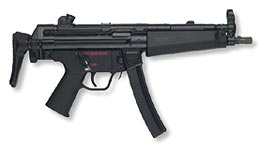Menu Tambahan:
Social Politics:
Dari Partai Politik ke Gerakan Sosial
Religion:
Refleksi Kebangkitan Tarbiyah
Fiqh Sunnah 1 (Sayyid Sabiq)
Science Technology:
Berita IPTEK
Military and Intelligence:
US Firearm
US-USSR Armour Vehicle
US-USSR Aircraft & Helicopter (1)
US-USSR Aircraft & Helicopter (2)
Balance of Power in South East Asia
|
M1911A1 .45 Caliber Pistol 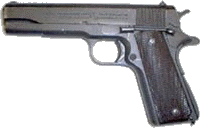 Function: Semiautomatic pistol. Description: The .45 caliber semiautomatic pistol M1911A1 is a recoil-operated hand weapon. It is a magazine-fed semiautomatic weapon, which fires one round each time the trigger is squeezed once the hammer is cocked by prior action of the slide or thumb. This design is referred to as "single action only." The thumb safety may only be activated once the pistol is cocked. The hammer remains in the fully cocked position once the safety is activated. (Note: More modern pistol designs of the "double action" type will allow the hammer to move forward to an uncocked position when the thumb safety is activated.) The M1911A1 was widely respected for its reliability and lethality. However, its single action/cocked and locked design required the user to be very familiar and well-trained to allow carrying the pistol in the "ready-to-fire" mode. Consequently, M1911A1s were often prescribed to be carried without a round in the chamber. Even with this restriction on the user, numerous unintentional discharges were documented yearly. History: The M1911A1 had been the standard handgun issued to Marines for many decades. Selected weapons were modified in the 1980s to meet the requirements of the MEU(SOC) in lieu of arming them with the M9 9mm pistol. Description:
This weapon is a modified M1911A1 .45 caliber pistol sometimes referred
to as "near match" or "combat accuratized."
The MEU(SOC) Pistol is the designated "backup weapon"
of Marines armed with the 9mm MP5-N Close Quarters Battle weapon.
The M1911A1 was chosen for this role (and its modifications generated)
because of its inherent reliability and lethality, and because the
MEU(SOC) modifications make the M1911A1 design more "user friendly."
The unique characteristics of the MEU(SOC) pistol are: commercial/competition
grade ambidextrous safety, precision barrel, precise trigger, and
rubber coated grips, rounded hammer spur, high profile combat sights,
and an extra-wide grip safety for increased comfort and controllability
(which aids in a quick follow-up second shot). The issue magazines
are replaced with stainless steel competition-grade magazines with
rounded plastic follower and extended floor plate Background:
The weapon modifications were designed in 1986 to meet the requirements
of the MEU(SOC). Each pistol is hand-built by specially trained
armorers at the Rifle Team Equipment (RTE) shop, Quantico, Virginia Description: The
M9 is a lightweight, semiautomatic pistol manufactured by Beretta
and designed to replace the M1911A1 .45 caliber pistol and .38 caliber
revolvers. The M9 has redundant automatic safety features to help
prevent unintentional discharges. It can be fired in either double
or single action mode and can be unloaded without activating the
trigger while the safety is in the "on" position. The
M9 pistol has a 15-round magazine, and may be fired without a magazine
inserted. This weapon can have the hammer lowered from the cocked,
"ready to fire," position to the uncocked position without
activating the trigger by placing the thumb safety on the "on"
position. Background: The 9mm
Pistol Program was a Congressionally-directed Non-Developmental
Initiative to standardize DoD with NATO and field one handgun for
all United States armed services. Beretta of Italy was awarded a
multi-year contract for delivery of over 500,000 pistols. The contract
award stipulated that production of the weapon must transition from
Italian to US production after two years. The US Army is the lead
service in this program. History: Introduced
in 1988 as the Army's designated sniper weapon system, the M24 SWS
the first bolt action rifle to see dedicated service with the US
Army since the .30-06 caliber Springfield Model 1903. With the withdrawl
of the Springfield 03 during the Second World War, all army sniping
activities have been carried out, more or less, with either scoped
regular-issue rifles (in the case of the M1C and M1D) or match-grade
variants of issue rifles (as in the case of the M21 sniper rifle.) While the use of issue rifles has eased the logistical
demands on the army supply system, the use of semi-automatic rifles
for sniping applications is not with out serious drawbacks. Although
the M21 is a very accurate weapon, it is not designed to stand up
to battlefield abuse. The wood stock was subject to warping, the
gas operating system was subject to fouling and contamination, and
because the weapon was semi-automatic there was no way to ensure
every round was chambered in exactly the same way. All of these
conditions could grossly affect the accuracy of the rifle beyond
500 yards. In light for these limitations, the Army initiated
a program in the 70's to re-introduce a bolt-action sniper rifle
to its inventory. Eventually, the weapon the Army settled on was
the M24 bolt-action rifle. Chambered for 7.62mm NATO (.308 Winchester)
the M24 is based on the Remington Arms 700 action and is very similar
to the civilian 40X target rifle and the Marine Corp's M40 series
rifle. As with the M40, the M24 utilizes a custom-built
fiberglass stock but with an adjustable cheek pad as well as an
adjustable pad on the butt stock to adjust length of pull. Both
utilize an internal 5 round magazine, are scoped, and are adaptable
to the use of night vision devices and weapon scopes. The greatest
difference between the two is the fact that the M40 is a "short"
action and the M24 is a "long" action. The reason for
this difference is the Army ultimately wanted to adopt a more powerful
.30 caliber cartridge (such as the .300 Winchester Magnum) which
would require the "long" action to extract the larger
cartridges in its re-chambered sniper rifles. Description: The M24
Sniper Weapon System is a bolt-action rifle chambered to fire 7.62mm
NATO (currently either the M118 Special Ball Cartridge or the M852
Match Cartridge, though it can fire any standard NATO 7.62mm cartridge.)
The Kevlar-reinforced fiberglass stock is custom built by HS Precision
and incorporates an adjustable cheek pad and as well as an adjustable
pad on the butt stock to adjust length of pull. The 24" barrel
is bolted to the full-length aluminum bedding block in the stock
to reduce vibration and loss of zero. The scope is a Leupold &
Stevens Mk. IV M3A day telescope and is mounted on the rifle using
Mk. IV rings and base. Background: Originally developed by the 10th Special
Forces Group at Ft. Devens, the M25 was built as a joint services
system, meeting the needs of both Army SF and Navy SEAL sniper teams
for a semi-automatic sniper rifle built on the same lines as the
match grade M14 and M21 semi-automatic rifles. The M25 is not a
replacement for existing bolt-action rifles, such as the Army's
M24 and the Marine Corps' M40A3, but rather the M25 is intended
to serve as a sniper support weapon for the sniper team observer.
The M25 will provide the sniper observer with a more effective support
weapon than the M16/M203, capable of delivering very accurate fire
out to 500 meters. In addition, the M25 will fill a mission specific
role as an urban area sniper rifle, where ranges are limited and
high rate of fire is the primary concern. Chambered for 7.62mm NATO
(.308 Winchester) the M25 is capable of firing any 7.62mm ammunition,
though it was designed to fire the same ammunition (M118 and M852
Match and Special Ball ammunition) that the M40A3 and the M24 currently
fire. Description: Physically,
the M25 is very similar in appearance to the M14/M21 semi-automatic
rifle. The M25 uses National Match grade components, to include
barrel, receiver, trigger assembly and spring guide, and a custom
built gas cylinder. The barrel is glass bedded to a synthetic McMillan
stock and the Advanced Scope Mounting System is manufactured by
Brookfield Precision Tool. The M25 has been equipped with a number
of scopes, to include the Bausch & Lomb10x Tactical scope, the
Leupold Ultra MK4 series (M1 and M3)as well as the Leupold VariX-III
LR M3. History: Introduced
in 1966 the M40 sniper rifle is the precursor to all modern American
military sniper weapons. Before the M40 was introduced, sniping
functions were performed by battle rifles that had been adapted
(match grade components and barrel, quality optics) for the purpose.
The original M40 rifles were military grade Remington Model 700
bolt action rifles chambered to fire the NATO 7.65mm (.308 Winchester)
cartridge and built to Marine Corps specifications and delivered
in 1966. By the mid 1970's the weaknesses of the original
M40 had become evident and the Marine Corps initiated a program
to refurbish and improve the M40. Designated the M40A1, the improved
rifle incorporated a fiberglass stock, which not only made the rifle
lighter and more durable but also made the rifle far less susceptible
to atmospheric influences such as temperature and humidity. In addition,
the rifle's original scope was replaced by one custom built for
USMC sniping applications. This refurbishing was performed completely
"in house" by Corps armorers at the Quantico Armory. The M40A1 underwent another upgrade in the late
1990's, and was re-designated the M40A3. The M40A3 is still based
on the Remington 700 action, though many of its components are after
market (non-Remington), and custom built. The M40A3 retains the
same optical sight as was built for and used on the A1, and the
new fiberglass stock is adjustable for length of pull and is equipped
with an adjustable cheek pad. In addition, the M40A3 is the first
USMC sniper rifle to incorporate an attached bi-pod. As A1's rotate
through the Quantico Armory they will be upgraded to the A3 standard. Description: The
original M40 was a direct adaptation of the Remington 700/40XB match-grade
target rifle fitted with a Redfield 3-9x accu-range variable power
scope, and chambered to fire the NATO 7.62mm cartridge (.308 Winchester.)
The M40A1 saw the introduction of the McMillan fiberglass
stock and replaced the Redfield scope and mounting ring set with
a 10x scope custom built for the Marine Corps by Unertl. The M40A3
replaces the original McMillan fiberglass stock with the newer McMillan
A4 model, which incorporates adjustable length of pull and cheek
pad. The original trigger and Unertl base assembly has been replaced
by ones custom built by D. D. Ross, while the Unertl scope mounting
rings have been replaced by ones manufactured by G &G Machine.
The A3 also incorporates a Harris bipod and accessory rail, which
is also manufactured by G &G Machine. Though the M40 series rifles are capable of firing
any NATO 7.62mm (.308 Winchester) round, the Marine Corps has developed
the M118LR cartridge for sniping applications. History: Various
models of shotgun have been in service use since 1901. The current
inventory consists of four different 12 gauge shotgun models: Remington
870, Winchester 1200, Mossberg 500, and Mossberg 590 (weight and
length of the weapon depend on the manufacturer. Description: The
12 gauge shotgun is a manually operated (pump), repeating shotgun,
with a seven-round tubular magazine, a modified choke barrel, ghost
ring sights, and is equipped with a bayonet attachment, sling swivels
and a standard length military stock with phenolic plastic buttplate
(some models have wooden and/or folding stocks). This special purpose
individual weapon is used for guard duty, prisoner supervision,
local security, riot control, and any situation which requires the
use of armed personnel with inherent limited range and ammunition
penetration. History: Procured by
the U.S. Army during the Gulf War for combat engineers performing
explosive ordnance disposal operations, the Barrett M82A1 Special
Application Scoped Rifle (SASR) soon began to see service with Special
Operations Forces as a long-range counter sniper and anti-materiel
weapon. Since the Gulf War, the M82A1 has been replaced by the bolt
action M95 caliber .50 rifle for use in engineer EOD operations,
yet remains in service with SOF and peacekeeping forces as a counter-sniper,
anti-material weapon. Description: Produced
by Barrett Firearms Manufacturing, the M82A1 Special Application
Scoped Rifle is an air-cooled, semi-automatic rifle equipped with
a 10x Unertl scope mounted on a mil. spec. sight rail and 10 round
detachable box magazine. Firing M2 Caliber .50 Browning Machine
Gun cartridges, the M82A1 is capable of engaging man-sized targets
out to 1500m, armored targets out to 2000m and is capable of penetrating
up to 30mm of steel plate. To keep the felt recoil to a minimum, the M82A1
utilizes the short recoil principle developed by John Browning,
which diffuses the recoil energy over a longer period of time. To
further reduce recoil, the rifle barrel is equipped with a double-chambered
muzzle brake, which redirects expended cartridge gasses to the sides
and rear of the muzzle. Though the primary round for the M82A1 is the Raufoss
Grade A match-grade multi-purpose cartridge, the M82A1 can fire
all types of caliber .50 BMG ammunition, with the exception of the
M903 SLAP (Saboted, Light Armor Penetrator) and the M962 SLAPT (Saboted,
Light Armor Penetrator- Tracer.) History: At one time
the standard issued rifle for Marines, the M14 is now used primarily
in the Competition in Arms program, or for drill and ceremonial
purposes. The M16 replaced the M14 as the Table of Organization
rifle for the Marine Corps during the Vietnam War. Description: The
M16A2 5.56mm rifle is a lightweight, air-cooled, gas-operated, magazine-fed,
shoulder- or hip-fired weapon designed for either automatic fire
(3-round bursts) or semiautomatic fire (single shot) through the
use of a selector lever. The weapon has a fully adjustable rear
sight. The bottom of the trigger guard opens to provide access to
the trigger while wearing winter mittens. The upper receiver/barrel
assembly has a fully adjustable rear sight and a compensator which
helps keep the muzzle down during firing. The steel bolt group and
barrel extension are designed with locking lugs which lock the bolt
group to the barrel extension allowing the rifle to have a lightweight
aluminum receiver. Background: The M16A2
rifle is a product improvement of the M16A1 rifle. The improvements
are: - a heavier, stiffer barrel than the barrel of the
M16A1; The launcher also has a quadrant sight which may
be attached to the M16A2 carrying handle and is used when precision
is required out to the maximum effective range of the weapon. History: The M203
was designed and procured as the replacement for the M79 grenade
launcher of the Vietnam era. The Objective Individual Combat Weapon (OICW) provides
an enhanced capability for the 21st century infantryman, with the
potential to selectively replace the M16 rifle, M203 grenade launcher,
and M4 carbine. When fielded, the OICW dual munition system will
provide superior firepower to the U.S. Army, Marine Corps, Air Force,
Special Operations Command, Navy, and Coast Guard. Program guidelines were derived from the Small Arms
Master Plan (SAMP) and Joint Service Small Arms Master Plan (JSSAMP).
OICW was managed by JSSAP during the Advanced Technology Demonstration
(ATD) phase. For the PDRR/EMD phase, OICW management will transition
to PM Small Arms with support provided by ARDEC World-Class
Team The present inventory includes both suppressed
and non-suppressed versions of the MP5. The basic configuration
of this weapon makes for an ideal size, weight,and capable (accuracy,
lethality, reliability, etc.) close quarters battle weapon system Background:
This weapon is manufactured by Heckler and Koch and is presently
fielded to Marine Corps Force Reconnaissance Companies and Marine
Security Force Battalions. It is currently considered the main weapon
in the close quarters battle (CQB) environment Description:
The Squad Automatic Weapon (SAW), or 5.56mm M249 is an individually
portable, gas operated, magazine or disintegrating metallic link-belt
fed, light machine gun with fixed headspace and quick change barrel
feature. The M249 engages point targets out to 800 meters, firing
the improved NATO standard 5.56mm cartridge. The SAW forms the basis
of firepower for the fire team. The gunner has the option of using
30-round M16 magazines or linked ammunition from pre-loaded 200-round
plastic magazines. The gunner's basic load is 600 rounds of linked
ammunition. Background:
The SAW was developed through an initially Army-led research and
development effort and eventually a Joint NDO program in the late
1970s/early 1980s to restore sustained and accurate automatic weapons
fire to the fire team and squad. When actually fielded in the mid-1980s,
the SAW was issued as a one-for-one replacement for the designated
"automatic rifle" (M16A1) in the Fire Team. In this regard,
the SAW filled the void created by the retirement of the Browning
Automatic Rifle (BAR) during the 1950s because interim automatic
weapons (e.g. M-14E2/M16A1) had failed as viable "base of fire"
weapons. Early in the SAW's fielding, the Army identified the need
for a Product Improvement Program (PIP) to enhance the weapon. This
effort resulted in a "PIP kit" which modifies the barrel,
handguard, stock, pistol grip, buffer, and sights. Background:
The Marine Corps is replacing the M60E3 with the M240G. The ground
version of the M240 allows for a common medium machine gun throughout
the Marine Corps. History:
Numerous manufacturers originally produced the M2 Heavy Machine
Gun. Background:
The MK19 was originally developed to provide the U.S. Navy with
an effective riverine patrol weapon in Vietnam. A Product Improvement
Program was initiated in the late 1970s resulting in the MK19 Mod
3. Mission: To
destroy bunkers and other fortifications during assault operations
(as well as other designated targets with the dual mode rocket),
and destroy main battle tanks with the HEAA rocket. Description:
The SMAW is an 83mm man-portable weapon system consisting of the
MK153 Mod 0 launcher, the MK 3 Mod 0 encased HEDP rocket, the MK
6 Mod 0 encased HEAA rocket, and the MK217 Mod 0 spotting rifle
cartridge. The launcher consists of a fiberglass launch tube, a
9mm spotting rifle, an electro-mechanical firing mechanism, open
battle sights, and a mount for the MK42 Mod 0 optical and AN/PVS-4
night sights. The High Explosive, Dual Purpose (HEDP) rocket is
effective against bunkers, masonry and concrete walls, and light
armor. The High Explosive Anti-Armor (HEAA) rocket is effective
against current tanks without additional armor. The 9mm spotting
rounds are ballistically matched to the rockets and increase the
gunner's first round hit probability. Training is accomplished with
the MK7 Mod 0 encased common practice rocket and the MK213 Mod 0
noise cartridge. The SMAW MK153 Mod 0 launcher is based on
the Israeli B-300 and consists of the launch tube, the spotting
rifle, the firing mechanism, and mounting brackets. The launch tube
is fiberglass/epoxy with a gel coat on the bore. The spotting rifle
is a British design and is mounted on the right side of the launch
tube. The firing mechanism mechanically fires the spotting rifle
and uses a magneto to fire the rocket. The mounting brackets connect
the components and provide the means for boresighting the weapon.
The encased rockets are loaded at the rear of the launcher. The
spotting cartridges are stored in a magazine in the cap of the encased
rocket. History:
The SMAW system (launcher, ammunition and logistics support) was
fielded in 1984 as a Marine Corps unique system. At that time, the
SMAW included the MK153 Mod 0 launcher, the MK3 Mod 0 HEDP encased
rocket, the MK4 Mod 0 practice rocket and the MK217 Mod 0 9mm spotting
cartridge. The MK6 Mod 0 encased HEAA rocket is being added to the
inventory. The MOD 0 has demonstrated several shortcomings. A series
of modifications is currently planned to address the deficiencies.
They include a resleeving process for bubbled launch tubes, rewriting/drafting
operator and technical manuals, a kit that will reduce environmental
intrusion into the trigger mechanism, and an optical sight modification
to allow the new HEAA rocket to be used effectively against moving
armor targets. Recently fielded were new boresight bracket kits
that, when installed, will solve the loss of boresight problem between
launch tube and spotting rifle. During Desert Storm, 150 launchers
and 5,000 rockets were provided to the U.S. Army. Since then, the
Army has shown increased interest in the system. Description:
The AT-4 is a Swedish-manufactured, shoulder-launched anti-armor
weapon designed to defeat modern threat main battle tanks. (c) Copyright 2001 Abdur
Rahim |
|||||||||||||||||||||||||||||||||||||||||||||||||||||||||||||||||||||||||||||||||||||||||||||||||||||||||||||||||||||||||||||||||||||||||||||||||||||||||||||||||||||||||||||||||||||||||||||||||||||||||||||||||||||||||||||||||||||



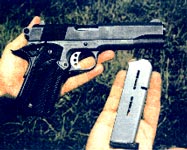
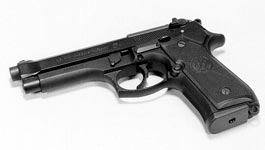


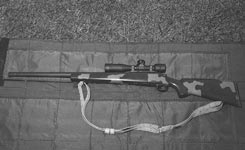




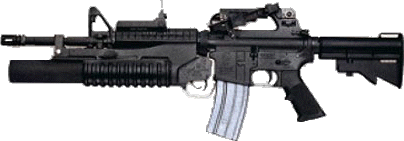
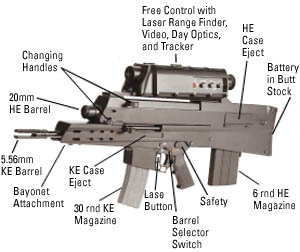


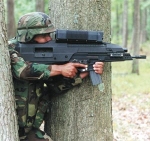 For
the ATD program, ATK served as system integrator, fuze developer
and 20mm HE developer. ATK formed a strong international team, including
Heckler & Koch (weapon), Contraves-Brashear Systems (fire control),
Octec (video tracker), and Dynamit Nobel (KE and propellant support).
For the PDRR/EMD program, the ATK team remains intact and will evolve
a combat ready system.
For
the ATD program, ATK served as system integrator, fuze developer
and 20mm HE developer. ATK formed a strong international team, including
Heckler & Koch (weapon), Contraves-Brashear Systems (fire control),
Octec (video tracker), and Dynamit Nobel (KE and propellant support).
For the PDRR/EMD program, the ATK team remains intact and will evolve
a combat ready system.